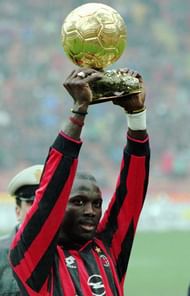It is a common observation that every league goes through its phases of highs and lows. Case in point, the La Liga in the last 9 years and the EPL for a decade before that. Juventus, under the tutelage of Antonio Conte and their current manager Massimiliano Allegri have won 6 Scudettos on the trot and they have been consistently improving on the European stage with two Champions League final appearances in the last three years.
But apart from the Old Lady, there haven't been many Italian teams who have done exceedingly well on the European stage. The last of the good teams being the Champions League winning teams of AC Milan under Ancelotti and Inter Milan under Jose Mourinho, both of which were almost a decade back.
It shouldn't be forgotten that there was a time when the whole world used to fear clubs from the Serie A. Italy was the centre of the footballing universe during the '80s and '90s. When the Serie A was at its peak, it was packed with legends gracing the pitch every week. The league held such a high entertainment value that even the other European countries started broadcasting Serie A matches with innovative match day programmes.
Since the Calciopoli happened though, its international appeal took a hit and only the very passionate fans outside Italy regularly follow the league now. The silver lining seems to be back now with teams like Inter Milan, Roma and Napoli looking strong after years of constructive rebuilding and upgrading.
Serie A still remains one of the best leagues in the world and for this reason, let us see how it all took shape over the years.
Inception

Organised football started in Italy in the year 1898 under Federazione Italiana Giuoco Calcio (Italian Football Federation). It was played as a regional competition for a few years until the year 1921, which saw more teams pouring in. This lead to a debate between the main teams and FIGC on the number of teams to be allowed in the competition.
Eventually, there was a split and this lead to the formation of Confederazione Calcistica Italiana (CCI) which conducted the tournament with the main teams independent of the FIGC for a year (1921-1922). After a year, FIGC accepted to reduce the number of teams participating and created one single league albeit with the North and South divisions being played separately.
The Serie A as we know it formed in the year 1929 with teams across the country taking part in it. A total of 18 clubs took part in the league in its first season with Inter Milan (then known as Ambrosiana) winning the Scudetto (which means “small shield” in Italian).
The league follows a small tradition where a team with ten Scudettos can wear a star on their club's crest. Hence you see both the Milan clubs having one star above their crests and Juventus having 3.
The Sette Sorelle and domination of Northern Italy

Not so long ago, during the 1980s to late 2000s, Italian clubs were the powerhouses of club football. And to be very specific, seven clubs (Sette Sorelle), Juventus, Milan, Inter, Roma, Lazio, Fiorentina and Parma were fighting each other for the top honours week in and week out.
These two decades are famously known as the “Golden Era” of Italian football as the Italian league was highly competitive within the league and also in Europe. Between 1983 and 2003, Serie A teams were finalists in 13 European competitions, winning 6 of them.
It is interesting to see that 4 of these 7 clubs are from the north of Italy. Traditionally, clubs from the north have always dominated the league as it can be seen in the number of league wins by the northern teams: Juventus(33), Inter Milan and AC Milan (18 each), Genoa (9), Torino, Pro Vercelli and Bologna (7 each). That's a whopping 99 out of 113 titles and it does not look like it will stop anytime soon.
Ballon d'Or

The Italian league is home to more Ballon d’Or winners (before the merge with FIFA World Player of the Year) than any other league. Italian clubs have produced 14 different Ballon d'Or winners since its genesis.
Some of the notable winners include Juventus legend Zinedine Zidane, George Weah in his very first season at AC Milan, Marco van Basten (3 times) and Ruud Gullit (1 time) under the tutelage of Arrigo Sacchi at AC Milan and Ronaldo at his peak with Inter Milan.
Michel Platini, long before he was found guilty in the FIFA corruption scandal along with Sepp Blatter, won the Ballon d'Or 3 consecutive times with Juventus during his prime years. Fabio Cannavaro is the last Italian and non-attacker to win the Ballon d'Or after a scintillating season with Real Madrid and the Italian National team.
Scandals

Italian football was plagued by scandals of multiple kinds for decades. The worst of them being Calciopoli of 2006. Many clubs including Juventus and AC Milan were caught being a part of a huge match-fixing network where the teams paid the referees to influence results.
Juventus took the worst hit as they were relegated to Serie B and were stripped off of the title. Milan were given a penalty of 30 points and teams like Lazio and Fiorentina were banned from European football.
The scandal had such a huge impact on the league that since then, the clubs and the league as a whole have been on a rapid downfall in terms of revenue generated. As a result, the league finds itself in the 4th position on the UEFA Coefficient.
Legends of the game

Before Messi and Ronaldo entered the fray, there were players like Gianluigi Buffon, Zinedine Zidane, Javier Zanetti, Paolo Maldini and Alberto Gilardino, and most recently Kaka, who were breaking records and reinventing how football was played. And the list is quite frankly very long.
There were a few players who have had a lasting impact on the game on an international scale though. Roberto Baggio, widely considered as the best Italian to ever grace the pitch, played for several Italian clubs and had a long trophy-laden career.
Ronaldo (The Phenomenon) bulldozed through defences and became an idol to thousands of footballers all over the world. Alessandro Del Piero, Francesco Totti and Zanetti showed the world what loyalty means by staying with their respective clubs through thick and thin.
Serie A was also the home to some of the most unrivalled managers like Arrigo Sacchi, Carlo Ancelotti, Marcelo Lippi, Fabio Capello and Giovanni Trapattoni. They made the Italian School of thought famous and even took it to other leagues later on in their careers.
